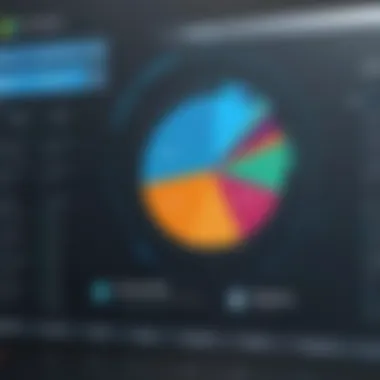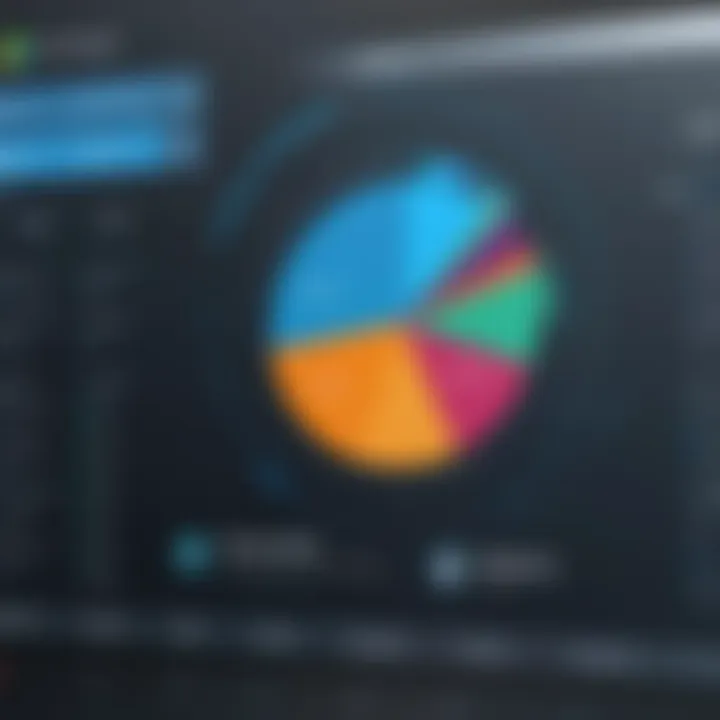Analyzing Microsoft Defender Antivirus Pricing Strategies


Intro
In today's digital world, the landscape of cybersecurity is constantly shifting. As threats evolve, both individuals and businesses find themselves in the crosshairs of malicious actors. Knowing how to protect yourself or your organization is critical. That's where tools like Microsoft Defender Antivirus come into play. It's not just about having antivirus software; it's about understanding its pricing and the implications it has for protecting one's digital assets.
Microsoft Defender offers varying pricing models which are tailored to different user needs, encompassing individual users and massive enterprises alike. This analysis will give you a deeper insight into Microsoft's offerings, especially in an age where cyber threats are increasingly sophisticated.
Cybersecurity Threats and Trends
Notable cybersecurity threats in the digital landscape
The digital realm is rife with threats that can compromise personal and organizational data. From phishing scams that trick individuals into revealing private information to ransomware attacks that can cripple entire networks, it's a minefield out there. Attackers are constantly devising new ways to exploit vulnerabilities. Recent reports have indicated a significant uptick in the use of artificial intelligence in crafting those attacks, making them even harder to identify.
Emerging trends in cyber attacks and vulnerabilities
As the tactics of cybercriminals evolve, so too do the strategies we use to defend against them. For instance, the increase in remote work has led to a spike in attacks targeting unsecured home networks. Additionally, trends show that supply chain attacks are becoming more prevalent, targeting smaller entities that are less secure in hopes of pulling down larger companies.
Impact of cyber threats on individuals and businesses
The stakes are high. Individuals may face identity theft, while businesses can suffer reputational damage, financial losses, and even legal consequences. A recent survey found that nearly 60% of small to medium enterprises which experienced an attack had to shut their doors within six months. Understanding these trends is crucial for choosing the right antivirus software, and that includes evaluating options like Microsoft Defender.
Microsoft Defender Pricing Structure
Understanding the pricing models available
Navigating the pricing structures for Microsoft Defender can be confusing. Microsoft offers plans that range from free basic protection to comprehensive packages suitable for businesses. This stratification is aimed at meeting the diverse needs of users, from home users to large organizations.
Cost comparisons with competitors
When comparing Microsoft Defender to its competitors, one might notice that while some rivals charge considerably high fees for their service, Microsoft tries to keep its pricing competitive without compromising on essential features. For example, Norton and McAfee often charge separately for customer support services, while Microsoft integrates it into their plans at no additional cost. This factor can make a significant difference in overall value.
End
Understanding the financial aspects of cybersecurity is not just about picking a tool; it’s about making an informed decision that aligns with your needs. By analyzing the pricing structure of Microsoft Defender Antivirus and comparing it to competitors, users can make choices that best protect them against the evolving threats in the digital landscape. Ultimately, this guide serves to enhance your understanding of Microsoft Defender, ensuring that you're not just equipped with knowledge but also prepared for securing your digital life.
Prologue to Microsoft Defender Antivirus
Understanding the role of Microsoft Defender Antivirus in today's digital landscape is crucial for anyone navigating cybersecurity. As threats have evolved from simple viruses to sophisticated malware and ransomware, having an effective antivirus solution is not just a good idea but a necessity. Microsoft Defender stands out in this environment — it’s integrated into Windows systems and works as the first line of defense for millions of users.
Overview of Microsoft Defender
At its core, Microsoft Defender Antivirus aims to provide security by detecting, preventing, and removing malicious software. Unlike some competitors, it is bundled with Windows operating systems, ensuring that every user has at least a basic level of protection. However, this isn't just a basic protection plan; it offers features that rival paid alternatives, including real-time protection and cloud-based analysis. Features such as controlled folder access, which locks down files against unauthorized changes, highlight its commitment to comprehensive defense.
Historical Context and Development
The journey of Microsoft Defender began in the 1990s when it was first released as "Microsoft AntiSpyware". It was transformed into an antivirus solution after the acquisition of technology from Sybari Software in 2005. This historical context demonstrates Microsoft's awareness of the changing landscape of cybersecurity. Over the years, continuous development and updates have led to its current incarnation, which is not only integrated into Windows operating systems but effectively adapts to emerging threats.
Understanding Pricing Structures
Understanding the pricing structures of Microsoft Defender Antivirus is crucial in today's fast-paced digital environment. With cyber threats evolving constantly, the choice of security software can make a significant difference in protecting sensitive data. This section will delve deep into how Microsoft Defender's pricing models work and the implications they have for various user groups.
Examining pricing structures isn't just about the cost; it also includes the value associated with each tier, whether free or paid. Different consumers or organizations will weigh factors like features, usability, and customer support differently. Therefore, knowing how the pricing is structured across various offerings can empower users to make informed decisions that effectively align with their specific needs.
Free vs Paid Variants
The offer of a free version of Microsoft Defender Antivirus is one of its most compelling aspects. Many users appreciate the fact that they can access basic security measures without opening their wallets. This free variant generally provides essential protection features, such as:
- Real-Time Threat Protection: Continuous scanning and detection of potential threats to mitigate risks immediately.
- Basic Malware Removal: Capabilities to remove common malware without much hassle.
- Firewall & Network Protection: Safety mechanisms to safeguard data as it flows in and out of your network.
However, while the free version covers many fundamental aspects, it often lacks the deeper protective features that can be crucial in today's cyber landscape. For example, paid variants typically include:
- Advanced Threat Protection: Mechanisms that utilize machine learning to adapt to new forms of malware and attacks.
- Multi-Device Licensing: Allowing users to protect multiple devices without the need for a separate purchase for each one.
- Dedicated Customer Support: Immediate support for more complicated issues, which is often missing in the free version.
Ultimately, the choice between free and paid versions comes down to individual needs. An individual user or small business may find the free version sufficient, while larger enterprises typically require the depth of protection offered in paid packages.
Subscription Models Explained
Subscription models for Microsoft Defender Antivirus introduce a layer of predictability in budgeting for cybersecurity. With options typically ranging from monthly to annual fees, these models can be tailored to fit business cycles or personal finances.
The essence of a subscription model is its simplicity and continuity. Users pay a recurring fee for access to the software and its updates. This ensures that the protection remains current as the antivirus varieties adapt to an ever-changing threat landscape. Subscriptions usually come in different tiers, with each level unlocking varying features:


- Basic Tier: Includes essential features akin to the free model but often with enhanced user support.
- Standard Tier: Incorporates advanced security features, multiple device protection, and some customization options.
- Premium Tier: Offers exhaustive coverage, including mobile device security, family protection options, and priority support.
By adopting a subscription approach, Microsoft Defender can continually update its software, which is pivotal in a world where new vulnerabilities emerge on a daily basis. With a subscription, users are more likely to remain cognizant of security updates, rather than risking lags in protection associated with one-time purchase models.
It's also worth contemplating how subscription models help companies stabilize income. This ongoing relationship with customers allows the software provider to enhance its products based on user feedback, which in turn nurtures customer loyalty.
In summary, understanding the nuances of pricing structures, especially between free and paid variants along with subscription models, allows users to navigate the often murky waters of cybersecurity choice with more confidence. Such insights can lead to not just better financial decisions but also significantly improve overall security posture.
Comparative Analysis with Competitors
When navigating the landscape of antivirus solutions, understanding how Microsoft Defender Antivirus stacks up against its competition is crucial. In an era where cyber threats loom large, consumers and businesses alike must prioritize effective protection beyond all the marketing fluff. This section delves into the competitive dynamics of the antivirus market, shedding light on noteworthy elements, benefits, and considerations involved in a comparative analysis.
Leading Antivirus Alternatives
As the digital realm expands, a host of antivirus solutions has emerged, each claiming to be the best for protecting your devices. Notable competitors to Microsoft Defender include:
- Norton Antivirus: Known for its robust features, it offers extensive customer support and multiple layers of malware defense.
- McAfee Total Protection: Offers a suite that covers multiple devices; it emphasizes identity theft protection, which appeals to those worried about personal data breaches.
- Kaspersky Internet Security: Renowned for its high detection rates, Kaspersky often garners praise from users for its effective real-time scanning capabilities.
- Bitdefender Antivirus Plus: This option provides a perfect blend of performance and protection, often topping charts for system impact and ease of use.
While these solutions shine in specific areas, Microsoft Defender’s integration within the Windows ecosystem presents a unique advantage. For most users, its effectiveness is already built into their operating system, posing a significant convenience and potentially lower total cost of ownership. However, one cannot overlook the premium features offered by these alternatives, which might just tip the scales according to personal or corporate needs.
Value Comparison of Key Players
When assessing the true value of these antivirus solutions, multiple factors swing into play. Consider the following aspects when comparing:
- Price Points: Microsoft Defender comes free with most Windows installations, while competitors typically have subscription fees that can stack up over time. For budget-conscious users, this initial cost difference significantly impacts the decision-making process.
- Feature Set: Although Microsoft Defender has improved its offerings, paying competitors often include nuanced features such as VPN services, parental controls, and advanced identity theft protection measures. This breadth may cater better to users seeking comprehensive solutions.
- Efficacy Ratings and Testing: Third-party testing organizations like AV-Test and AV-Comparatives regularly benchmark antivirus software. In recent assessments, Microsoft Defender has garnered respect, but alternatives like Norton and Kaspersky consistently score higher across various categories.
- User Experience and Accessibility: Defender’s native presence in Windows means users experience seamless updates and integration. Nevertheless, some alternatives provide dedicated dashboards and complex analytics, appealing to advanced users developing an IT strategy.
"In the realm of antivirus software, the best choice often aligns with user needs; features that cater to specific requirements can change the game entirely."
Cost Effectiveness of Microsoft Defender
In the current landscape of cybersecurity, evaluating the cost-effectiveness of antivirus solutions is not just a matter of analyzing the price tag. It extends beyond mere numbers, considering the overall value provided by the software in protecting devices and sensitive information. Microsoft Defender Antivirus stands out not only for its accessibility but also for the benefits it brings to a variety of users, ranging from individual consumers to large organizations. By investigating this aspect thoroughly, we can unearth how Microsoft Defender aids users in saving money while ensuring robust protection in a digital world filled with threats.
Potential Savings Over Time
Policies in cybersecurity can be likened to insurance; an investment that helps in mitigating potentially devastating losses. When diving into Microsoft Defender’s cost savings, several factors come into play.
- No Subscription Fees: For many users, the biggest draw of Microsoft Defender is that it comes at no additional cost for Windows users. This is unlike many competitors that require annual subscriptions. The avoidance of these recurring fees is a considerable advantage for consumers.
- Reduced Malware Incidents: The effectiveness of the antivirus software against malware means fewer disruptions. Each incident can be costly due to downtime, recovery efforts, and even potential data loss. By utilizing a capable and free service, a user can save significantly on the costs associated with these incidents.
- Bundled Features: Microsoft Defender offers a suite of features such as firewall protection and performance optimization tools inclusive in its package. This could render external purchases unnecessary, effectively cutting expenses.
In essence, these savings accumulate over time, making the use of Microsoft Defender a financially prudent choice for many.
Assessing the Return on Investment
When discussing return on investment (ROI) in the context of antivirus solutions, one must look at how effectively the software safeguards assets relative to its cost. Microsoft Defender offers some key points worth considering:
- Comprehensive Protection: With features like real-time threat detection and regular updates, the software ensures that devices remain secure. This can reduce the risk of costly breaches and restore efforts.
- User-Friendly Interface: The straightforward design minimizes the need for extensive training or IT support. This could translate to savings in time and resources, especially for businesses.
- Community and Support: Microsoft has established a platform for user engagement where experiences and tips are shared through forums. This can lead to an improved understanding of potential threats and ways to navigate them, effectively increasing the software’s value without extra costs.
Ultimately, assessing the ROI of Microsoft Defender involves looking beyond initial costs. Factors such as efficiency, feature inclusivity, and community support align to yield significant advantages against many paid alternatives. As businesses and individual consumers budget their cybersecurity costs, it's clear that Microsoft Defender often emerges as the preferred choice.
"ROI in antivirus solutions should not simply be about purchase price; it's about the value and protection that safeguards your assets effectively."
In summary, both potential savings and ROI analysis play a pivotal role in determining the cost-effectiveness of Microsoft Defender Antivirus. As users become increasingly aware of their online safety, understanding this value becomes more important than ever.
Key Features Impacting Pricing
When considering Microsoft Defender Antivirus, one cannot ignore the critical role that key features play in determining pricing. These features not only enhance the software's efficacy in safeguarding devices but also shape the purchasing decisions of potential users. The blend of functionalities offered directly correlates with the perceived value, influencing both individual and organizational buyers.
Real-Time Protection and System Impact
One pivotal aspect of Microsoft Defender Antivirus is its real-time protection capabilities. It operates continuously, scanning both incoming and outgoing files to thwart potential threats before they can inflict damage. In today’s fast-paced digital environment, this feature is essential. Users need assurance that they are safeguarded effectively, 24/7.
However, it’s not just about protection; the system impact of such features is also significant. Higher levels of real-time protection can sometimes lead to increased resource consumption. For some users, especially individuals or small enterprises with limited hardware, a resource-heavy tool can slow down operations. Evaluating this balance between robust security and system performance is essential when determining value.
Key points to consider include:
- Performance Overhead: How does real-time protection affect overall device speed?
- Resource Allocation: Is the antivirus utilizing necessary resources optimally, or is it hogging processing power, especially on older machines?
Ultimately, understanding these trade-offs is crucial. Users with heavy computational tasks might find themselves needing to invest in more robust systems or lighter alternatives, which further influences their budget.
Additional Security Tools and Services


Beyond basic antivirus capabilities, Microsoft Defender includes additional tools that add layers of protection and usability. These features can significantly impact pricing. Observing how they complement standard virus detection shapes user expectations and justifies costs.
For example, functionalities such as firewall management, cloud storage integration, and identity protection services enhance the overall protection framework. Each of these services not only amplifies security but also enriches user experience. Considerations here include:
- Firewalls: Built-in firewalls decrease vulnerability to unauthorized access, crucial for both individuals and businesses.
- Cloud Backup and Sync: This feature ensures that critical data remains safe, particularly if a ransomware attack occurs.
- User Experience Features: Tools like identity monitoring can alert users about suspicious activities, adding immense value without being overwhelming.
To truly grasp the ramifications of these features on pricing, users should be well-versed in their benefits. A careful examination can aid potential buyers in making an informed decision, ensuring that they are not just paying for antivirus software, but investing in a comprehensive security suite.
"In cybersecurity, every layer of defense counts. Understanding your tools can save you money and enhance protection."
In a nutshell, recognizing how fundamental features catalyze price dynamics within Microsoft Defender enriches user comprehension, illuminates needs, and ultimately guides decision-making. Assessing these characteristics alongside costs ensures a more rounded view of what Microsoft Defender truly offers to various user categories.
Target Audience and User Demographics
Understanding who uses Microsoft Defender Antivirus is crucial in evaluating its pricing and features. This section digs into the different user types that rely on the software, which can greatly influence what they are willing to pay or what they expect from the service. By recognizing the unique needs and behaviors of these groups, stakeholders can make clearer decisions regarding the pricing policies and feature sets that would be most beneficial.
Individual Consumers
Individual users often approach antivirus software with specific expectations shaped by their personal experiences and tech-savviness. This demographic typically prioritizes ease of use and budgetary considerations.
- Cost Sensitivity: Many are price-conscious, looking for free options or low-cost subscriptions. Microsoft Defender, with its base layer of free protection built into Windows, caters perfectly to this type of user, providing basic security without breaking the bank.
- User Experience: For everyday users, the integration of Defender into Windows means little-to-no setup is needed, appealing to those who might shy away from complex software installations.
- Support Needs: Non-technical individuals might appreciate robust customer support options, making it important for Microsoft to offer guidance alongside their antivirus product.
Due to these characteristics, pricing should ideally reflect an understanding of these users' budget constraints while still delivering a product that feels accessible and supportive.
Small to Medium Enterprises
The dynamic world of small to medium enterprises (SMEs) presents a different landscape for Microsoft Defender. These businesses must balance tight budgets with increasingly sophisticated cybersecurity threats.
- Cost-Benefit Analysis: SCRs often have to assess the return on investment when it comes to antivirus solutions. Microsoft Defender provides functions appealing to SMEs including essential security with the ability to expand functionality as budget allows.
- Scalability: Features that can grow with the business, such as easy upgrades or add-ons for additional devices, make the pricing strategy of Microsoft Defender attractive for SMEs looking for sustainability without overspending.
- Training and Adaptation: SMEs may require training resources for staff to properly utilize the software. If Microsoft could integrate simple training modules, it can better engage this demographic, justifying pricing models through enhanced efficiency.
The goal for SMEs is to maintain security without compromising resources allocated for growth, pushing Microsoft to ensure its product pricing emphasizes flexibility and adaptability.
Large Organizations and Institutions
When considering large organizations, the stakes ramp up significantly. These institutions often need comprehensive security solutions that are robust and effective, while also being mindful of compliance standards across different sectors.
- Enterprise-Grade Solutions: Large organizations look for more than basic antivirus. The business needs solutions that offer advanced security features such as threat intelligence and centralized management, aspects that influence how much organizations are willing to invest.
- Cost Justification: For large-scale users, it is essential that any proposed pricing structures connect directly to measurable outcomes—be it enhanced protection levels or reduced downtime due to malware incidents. This ties directly into the business continuity goals of such organizations.
- Custom Negotiations: Many large institutions expect customization in contracts. This could mean negotiating prices based on the scale of their operation, which enables Microsoft to offer tailored solutions without alienating smaller users who benefit from standard packages.
As these entities face complex security challenges and regulatory requirements, pricing should reflect the sophisticated nature of solutions needed while assuring organizations of long-term effectiveness and coverage.
"In the ever-evolving world of cybersecurity, knowing your audience is half the battle in building a successful product strategy."
In sum, articulating the preferences and requirements of the different target audiences not only aids in comprehending Microsoft Defender antivirus's positioning but also emphasizes the critical role demographics play in shaping its pricing structures.
Regional Variations in Pricing
The landscape of cybersecurity is rich and complicated, especially when it comes to pricing for services like Microsoft Defender Antivirus. A significant factor in determining how much a user pays is the regional differences that arise due to various economic and market conditions. Understanding these variations can provide much-needed insight for both individual consumers and organizations grappling with budget allocations for cybersecurity. In this section, we will explore how market demand shapes these prices, the impact of currency fluctuations, and how businesses can navigate these complexities.
Impact of Market Demand
Market demand is the driving force behind the pricing strategies of Microsoft Defender Antivirus. Simply put, when there's a high demand for antivirus solutions in a given region, prices tend to reflect that. For instance, in regions where cybersecurity threats are rampant - let’s say Southeast Asia - the demand for reliable antivirus solutions may be much higher than in areas where users have less exposure to threats.
This situation leads to a few interesting phenomena:
- Increased Investment: Companies operating in high-demand areas may offer tailored solutions, resulting in higher prices due to the perceived increased value.
- Competitor Influence: The presence of strong local competitors can drive prices down. Users in these markets often enjoy more competitive pricing; however, the value proposition may vary.
- User Base: Different demographics can impact how much consumers are willing to pay. For instance, a young, tech-savvy urban population may be more inclined to purchase more advanced features than a rural population with basic needs.
Understanding the relationship between demand and pricing is crucial for organizations looking to make smart financial decisions. The key is to align the choice of antivirus solution with their risk tolerance and specific market environment.
Currency Fluctuations and Pricing Strategies
Currency fluctuations also play a pivotal role in how pricing strategies are structured for Microsoft Defender Antivirus. Companies must adapt to the challenging reality where the value of currency is not static. Here are some points to consider regarding this aspect:
- Adapting to Exchange Rates: The prices of software and services could shift based on the strength or weakness of a local currency against the U.S. dollar or euro. If a country's currency depreciates, the cost of licensing on global platforms could increase significantly.
- Local Pricing: To mitigate the problems caused by exchange rates, some companies establish local pricing strategies. By adjusting prices based on the economic conditions of a specific region, Microsoft can ensure their product remains accessible to a broader audience.
- Long-term Contracts: For organizations looking at budget stability, committing to long-term contracts in a stable currency might safeguard against fluctuating operational costs, even if it means a sizable upfront investment.
In the end, these factors create a complex matrix of pricing strategies that can make the cost of Microsoft Defender Antivirus vary dramatically from one region to another.
"Not all solutions fit all regions; making sense of local demand and financial conditions is key to a successful purchase."
Understanding the intricacies of regional variations fuels informed decision-making. For businesses and individuals alike, being aware of these factors can mark the difference between a sound investment and an expensive misstep.


Customer Perceptions and Feedback
Understanding customer perceptions and feedback regarding Microsoft Defender Antivirus is critical for grasping its market position. In a world where cybersecurity is paramount, the sentiments of users serve as a litmus test for the product's effectiveness, value, and overall reliability. Furthermore, the feedback can often highlight concealed aspects that traditional marketing may overlook. Customers’ experiences dictate not only their likelihood of recommending the product but also their willingness to continue their subscription or choose an alternative. Therefore, insights gleaned from user opinions can greatly influence strategic decisions by businesses and individuals alike.
User Reviews and Ratings
When diving into user reviews and ratings, it becomes apparent that these metrics are more than mere numbers. They paint a vivid picture of customer satisfaction and product performance. For Microsoft Defender Antivirus, user ratings generally reflect a mix of appreciation and critique.
- High Marks for Integration: Many users laud the seamless integration of Defender into the Windows operating system. This ease of access enables even non-technical users to navigate security features with limited hassle.
- Critiques on Features: On the flip side, some reviews reveal dissatisfaction with certain features, such as the limited options compared to competitors, like Bitdefender and Norton. Users often express a desire for more customizable settings to enhance their security posture.
- Mixed Experiences: While some customers cite reliable real-time protection, others share experiences of missed detections, showcasing that experiences can vary significantly.
These reviews, often found on platforms such as Reddit or technology forums, can guide potential buyers in understanding the product's strengths and weaknesses.
Trustworthiness and Support Services
Trustworthiness is a cornerstone in any cybersecurity product. Microsoft Defender Antivirus generally enjoys a reputation for reliability, largely due to Microsoft's long-standing presence in the tech world. However, trust is not built on brand name alone; it is fostered through consistent performance and responsive support services.
- Reliability in Threat Detection: Users tend to have faith in Microsoft's strong focus on threat detection and updates. The regular updates ensure that the antivirus is tuned to counteract emerging cyber threats efficiently.
- Support Services: On the support front, experiences can differ widely. Some users find that Microsoft’s customer support is responsive and effective. Others, however, feel that the support services fall short when facing more complex issues. This variance can impact perceptions of overall trustworthiness.
In sum, understanding user reviews and perceptions about trustworthiness and support is vital. It not only informs prospective users but can also help Microsoft refine its offerings.
"Ultimately, customer feedback drives improvements in service and product offerings, and in the competitive landscape of antivirus solutions, it can make or break user loyalty."
Emphasizing the value of customer feedback allows Microsoft and similar companies to listen and adapt, ensuring they meet ever-evolving user needs.
Future Trends in Antivirus Pricing
The landscape of antivirus software is rapidly evolving, driven by the increasing complexity of cyber threats and the growing expectations of users. As cybersecurity becomes a household conversation topic, understanding future trends in antivirus pricing is essential for both individuals and organizations. This section explores how emerging threats and technological advancements shape pricing structures, providing valuable insights for stakeholders.
Emerging Threats and Their Impact on Pricing
In the cybersecurity realm, new threats emerge on a seemingly daily basis, ranging from ransomware attacks to sophisticated phishing schemes. These ever-evolving challenges have a direct effect on the pricing of antivirus solutions, including Microsoft Defender Antivirus.
In response to these threats, antivirus providers must regularly update their systems and algorithms to ensure the effectiveness of their products. This can lead to increased research and development costs, which are often passed on to consumers through pricing adjustments. For instance, companies may implement dynamic pricing models, where fees rise in response to specific threats. Additionally, some antivirus software may introduce tiered pricing plans that offer various levels of protection and features depending on the level of threat encountered.
Moreover, it’s crucial to comprehend how these threats drive value perception among users. As the stakes rise, users are likely to invest more in security solutions that demonstrate robust threat detection capabilities. For example:
- Increased License Costs: As companies bolster their defenses, rising license fees might reflect the software's enhanced security features.
- Bundled Services: Organizations may look for packages that include security training, threat assessments, and consultation services, which also contribute to the overall cost.
- Subscription Models: Users might find subscription services more attractive than one-time purchases because they offer continuous updates and support, which is vital considering the fast-paced nature of cyber threats.
"In a world where new threats lurk every corner, the value of a trusted antivirus solution cannot be overstated. Pricing adjustments usually reflect the need for elevated protection levels and continuous innovation."
Understanding this connection between emerging threats and pricing can empower consumers to choose solutions that not only fit their budget but also provide peace of mind in a volatile digital landscape.
The Role of Machine Learning and AI
Machine learning and artificial intelligence have emerged as front-line warriors in the fight against cyber threats. Their influence on antivirus pricing could be profound, as these technologies allow for more advanced detection methods and predictive capabilities that can outpace traditional defenses.
As antivirus companies incorporate AI into their products, they face significant costs in developing and maintaining these systems. These costs can translate into higher prices for consumers, but they also offer substantial long-term benefits. Potential impacts include:
- Proactive Threat Management: AI can detect threats before they escalate, potentially saving organizations money by preventing costly breaches.
- Automation Reducing Operational Costs: Automated threat detection methods can lead to cost savings in other operational areas, which can either offset higher software costs or result in lower prices over time.
- Enhanced User Experience: With machine learning, the software can learn and adapt to individual user behaviors, producing fewer false positives, which can improve overall user satisfaction.
For users, the integration of these technologies means investing in software that is likelier to keep pace with both existing and future threats. While the upfront costs may be higher, the long-term value is significant as users gain access to cutting-edge protection.
Culmination and Recommendations
As we draw to a close on our investigation into Microsoft Defender Antivirus pricing, it becomes absolutely clear that understanding this critical topic is not just a matter of convenience; it’s an essential step toward securing your digital life. In an era where cybersecurity threats are lurking around every corner, knowing what you’re paying for and how it aligns with your specific needs can significantly impact your overall cybersecurity posture. The insights gained here can guide not only your purchasing decisions but also your long-term security strategy.
Evaluating Your Needs
When it comes to antivirus solutions, a one-size-fits-all approach often fails to provide genuine satisfaction. Each user, whether an individual consumer or part of a larger organization, possesses unique requirements that demand careful consideration. Start by asking yourself some pertinent questions:
- What kind of devices are you looking to protect?
- Are you primarily concerned about malware, or do you need robust phishing protection as well?
- How important are additional features such as parental controls or VPN service?
Take your time to analyze these aspects. For instance, a small business may prioritize budget-friendly solutions without compromising on essential features. In contrast, a large institution might require advanced threat detection tools to counter sophisticated cyber attacks. Each decision relates closely to potential financial implications, so understanding your needs helps in selecting a suitable pricing model.
Making an Informed Decision
Once you have a clear understanding of your specific needs, the next step is making an informed decision. This isn’t just about picking the least expensive option—after all, the adage "you get what you pay for" often rings true in the realm of technology. Here are some thoughtful considerations:
- Compare Subscription Plans: Different plans may offer various levels of service and additional features. Ensure you fully understand what’s included.
- Read User Reviews: Engaging with user feedback on platforms like Reddit or Facebook can provide authentic insights. Sometimes, the theoretical benefits on paper may not translate into actual user satisfaction.
- Consider Future Needs: Technology evolves quickly. Make sure the option you choose isn’t just a fit for today but can also adapt to your needs down the road.
Ultimately, conducting due diligence can save you not only money but also potential headaches down the road. In the world of cybersecurity, knowing your worth is key!
"An ounce of prevention is worth a pound of cure." – Benjamin Franklin
Armed with the information presented in this article, you can navigate the complex landscape of Microsoft Defender Antivirus pricing and find a solution tailored to your specific cybersecurity needs.







